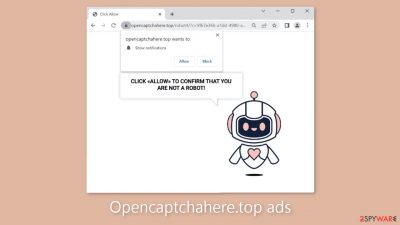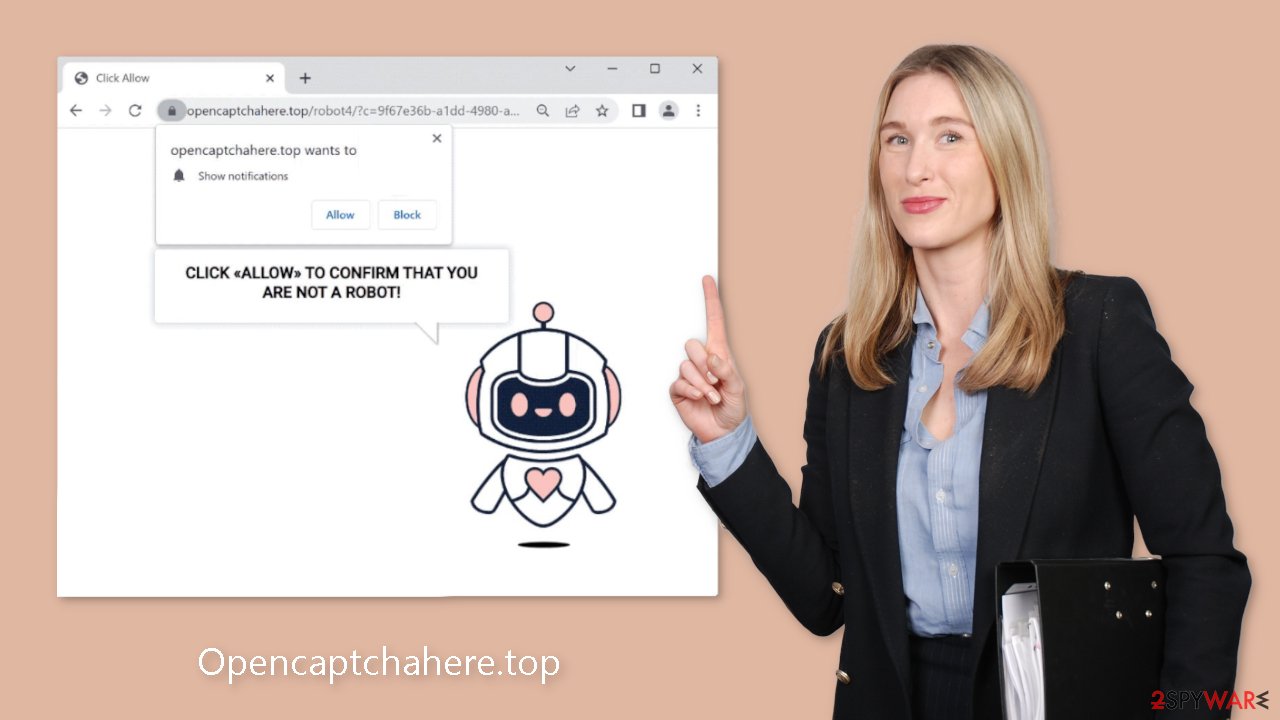Opencaptchahere.top ads (spam) - Free Guide
Opencaptchahere.top ads Removal Guide
What is Opencaptchahere.top ads?
Opencaptchahere.top is a dubious captcha website that generates revenue from pop-ups

Opencaptchahere.top is a fraudulent website created by scammers to generate revenue through pay-per-click advertising. To trick users into clicking the “Allow” button, the website employs social engineering[1] techniques. The website displays a misleading message implying that users must click the button to prove they are not robots.
After granting permission, the website may give users the false impression that they will be able to access the site's content. However, there is no other content to explore on the website. Instead, users are bombarded with annoying pop-up ads that can appear even after the browser has been closed.
| NAME | Opencaptchahere.top |
| TYPE | Push notification spam; adware |
| SYMPTOMS | Pop-up ads start appearing in the corner of the screen after the “Allow” button is pressed |
| DISTRIBUTION | Shady websites, deceptive ads, redirects, freeware installations |
| DANGERS | Links embedded in the push notifications can lead to dangerous websites where users can be tricked into providing their personal information and suffer from monetary losses |
| ELIMINATION | Users can block push notifications via browser settings |
| FURTHER STEPS | It is recommended to use a repair tool like FortectIntego after the removal to fix any remaining damage |
Distribution methods
Individuals frequently come across websites like Opencaptchahere.top as a result of failing to follow cybersecurity experts' safe browsing recommendations. It is critical for users to avoid unregulated and dubious pages. Illegal streaming websites, for example, are notorious for their deceptive advertisements and hidden redirects.
Social engineering techniques
Crooks employ a variety of messages and images in order to gain trust and appear legitimate. Users frequently encounter messages such as:
Press Allow to verify your age is 18+
Click Allow to watch the video
Download is ready. Click Allow to download your file
Press Allow to verify that you are not a robot
The primary goal of these sentences is to trick users into subscribing to push notifications unknowingly. The website's request that users confirm they are not robots is similar to a captcha verification process. A legitimate human verification process, on the other hand, would not prompt users to click “Allow” on a browser prompt.
Once users click “Allow,” scammers can begin making money. Unfortunately, they may use rogue advertising networks to display advertisements that direct users to dangerous websites. As a result, users may fall victim to scams attempting to obtain personal information, download potentially unwanted programs (PUPs),[2] and even malware. The end result can be financial losses, identity theft, and operating system damage.

Clear your browsers
Almost every website that users visit can use cookies to track their browsing activity. Cookies are small files that can store information such as an IP address, geolocation, links clicked, and online purchases. These details can be sold to ad networks or other third-party entities, raising serious concerns about user privacy and security.
To address this, security experts advise users to clear their browser data on a regular basis. The most practical solution for most users is to use a maintenance tool like FortectIntego. Such tools can delete cookies and cache automatically, optimize the machine, and repair any residual damage, which is especially useful after a virus infection.
Block Opencaptchahere.top notifications
Push notifications can only be turned on and off manually because they are subscription-based. Below is a detailed guide for the most popular browsers:
Google Chrome (desktop):
- Open Google Chrome browser and go to Menu > Settings.
- Scroll down and click on Advanced.
- Locate the Privacy and security section and pick Site Settings > Notifications.
![Stop notifications on Chrome PC 1 Stop notifications on Chrome PC 1]()
- Look at the Allow section and look for a suspicious URL.
- Click the three vertical dots next to it and pick Block. This should remove unwanted notifications from Google Chrome.
![Stop notifications on Chrome PC 2 Stop notifications on Chrome PC 2]()
Google Chrome (Android):
- Open Google Chrome and tap on Settings (three vertical dots).
- Select Notifications.
- Scroll down to Sites section.
- Locate the unwanted URL and toggle the button to the left (Off setting).
![Stop notifications on Chrome Android Stop notifications on Chrome Android]()
Mozilla Firefox:
- Open Mozilla Firefox and go to Menu > Options.
- Click on Privacy & Security section.
- Under Permissions, you should be able to see Notifications. Click Settings button next to it.
![Stop notifications on Mozilla Firefox 1 Stop notifications on Mozilla Firefox 1]()
- In the Settings – Notification Permissions window, click on the drop-down menu by the URL in question.
- Select Block and then click on Save Changes. This should remove unwanted notifications from Mozilla Firefox.
![Stop notifications on Mozilla Firefox 2 Stop notifications on Mozilla Firefox 2]()
Safari:
- Click on Safari > Preferences…
- Go to Websites tab and, under General, select Notifications.
- Select the web address in question, click the drop-down menu and select Deny.
![Stop notifications on Safari Stop notifications on Safari]()
MS Edge:
- Open Microsoft Edge, and click the Settings and more button (three horizontal dots) at the top-right of the window.
- Select Settings and then go to Advanced.
- Under Website permissions, pick Manage permissions and select the URL in question.
- Toggle the switch to the left to turn notifications off on Microsoft Edge.
![Stop notifications on Edge 2 Stop notifications on Edge 2]()
MS Edge (Chromium):
- Open Microsoft Edge, and go to Settings.
- Select Site permissions.
- Go to Notifications on the right.
- Under Allow, you will find the unwanted entry.
- Click on More actions and select Block.
![Stop notifications on Edge Chromium Stop notifications on Edge Chromium]()
Check your machine for adware
Unwanted browser behavior may also be attributed to potentially unwanted programs. At times, websites such as Opencaptchahere.top may emerge without any user input, which may be triggered by adware.[3] Adware is a program that generates commercial content, including pop-ups, banners, and redirects. Many of these programs are disguised as “helpful” tools, making them more challenging for average users to detect.
Therefore, it is crucial to have professional security tools like SpyHunter 5Combo Cleaner and Malwarebytes. Anti-malware solutions can scan the machine and detect suspicious processes running in the background. Additionally, it can prevent such infections by alerting users about dangerous files attempting to infiltrate the system. However, if users prefer to address the issue manually, they can follow our step-by-step instructions for both Windows and Mac machines:
Windows 10/8:
- Enter Control Panel into Windows search box and hit Enter or click on the search result.
- Under Programs, select Uninstall a program.
![Uninstall from Windows 1 Uninstall from Windows 1]()
- From the list, find the entry of the suspicious program.
- Right-click on the application and select Uninstall.
- If User Account Control shows up, click Yes.
- Wait till uninstallation process is complete and click OK.
![Uninstall from Windows 2 Uninstall from Windows 2]()
Windows 7/XP:
- Click on Windows Start > Control Panel located on the right pane (if you are Windows XP user, click on Add/Remove Programs).
- In Control Panel, select Programs > Uninstall a program.
![Uninstall from Windows 7/XP Uninstall from Windows 7/XP]()
- Pick the unwanted application by clicking on it once.
- At the top, click Uninstall/Change.
- In the confirmation prompt, pick Yes.
- Click OK once the removal process is finished.
Mac:
- From the menu bar, select Go > Applications.
- In the Applications folder, look for all related entries.
- Click on the app and drag it to Trash (or right-click and pick Move to Trash)
![Uninstall from Mac 1 Uninstall from Mac 1]()
To fully remove an unwanted app, you need to access Application Support, LaunchAgents, and LaunchDaemons folders and delete relevant files:
- Select Go > Go to Folder.
- Enter /Library/Application Support and click Go or press Enter.
- In the Application Support folder, look for any dubious entries and then delete them.
- Now enter /Library/LaunchAgents and /Library/LaunchDaemons folders the same way and terminate all the related .plist files.
![Uninstall from Mac 2 Uninstall from Mac 2]()
d
How to prevent from getting adware
Access your website securely from any location
When you work on the domain, site, blog, or different project that requires constant management, content creation, or coding, you may need to connect to the server and content management service more often. The best solution for creating a tighter network could be a dedicated/fixed IP address.
If you make your IP address static and set to your device, you can connect to the CMS from any location and do not create any additional issues for the server or network manager that needs to monitor connections and activities. VPN software providers like Private Internet Access can help you with such settings and offer the option to control the online reputation and manage projects easily from any part of the world.
Recover files after data-affecting malware attacks
While much of the data can be accidentally deleted due to various reasons, malware is one of the main culprits that can cause loss of pictures, documents, videos, and other important files. More serious malware infections lead to significant data loss when your documents, system files, and images get encrypted. In particular, ransomware is is a type of malware that focuses on such functions, so your files become useless without an ability to access them.
Even though there is little to no possibility to recover after file-locking threats, some applications have features for data recovery in the system. In some cases, Data Recovery Pro can also help to recover at least some portion of your data after data-locking virus infection or general cyber infection.
- ^ Social Engineering. Imperva. Learning Center.
- ^ Chris Hoffman. PUPs Explained: What is a “Potentially Unwanted Program”?. Howtogeek. Technology Magazine.
- ^ Adware. Malwarebytes. Cybersecurity Basics.













